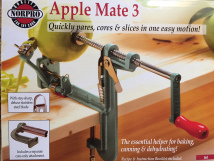Timing rules. Change waits for no machine. When I bought that apple coring machine, I expected to prepare and process our apple crop in record time. We had a somewhat smaller crop this year, but preparing the apples for storage in freezer or “canning” them in Ball jars is both very labor-intensive and slow. The new hand-crank machine would speed up the process immensely. And, it was only about twenty-four bucks.

Old American Technology, manufactured in China.
The apple and pear corer/peeler/slicer I bought to make this season’s processing easier worked great on the apples that had not yet begun to rot. It was clearly an old design, but, of course, the new product was made in China. It does seem of generally good quality.
So much good information on the internet can draw us into the lazy acceptance of claims that might not be entirely true. Reality sets in when we try to put such claims into practice. When it comes to coring apples, the operational characteristics of the machine must be met by the right condition of the apples to which we apply the clever design of the machine.
We had stored most of the apples in our root cellar for a couple of months as we busied ourselves with other projects. According to the “experts,” they should last in a root cellar all winter. Then we realized that some of the apples exhibited signs of decay. Time to core, peel, and slice those apples before it is too late.
Well, for many of the apples, even some that looked quite good on the outside, it was in fact too late to enjoy the benefits of that old design in a new machine that is otherwise capable of saving us lots of time. I quickly discovered how to rapidly operate the machine to produce cored and peeled apple slices. But I also quickly discovered the limits of the “apple-machine interface.”
Some of our apples looked great, but had begun to rot at the core. Much of the apple was still good, but the core was not. That resulted in a failure of the machine to core, peel, and slice the apple as it was designed to do.
The three coordinated functions of the machine all depended upon its ability to hold the apple steady as the operator cranked the handle that drives all three functions simultaneously. The machine grips the apple by means of three prongs that are inserted into the apple core.
However, if the core has rotted in any significant degree, it becomes rather mushy. Under that condition, the prongs cannot hold the apple against the forces of the peeling and slicing blades. The prongs slip within the core and nothing much else happens.
Now, of course one could manually cut out the core with a knife and save maybe a quarter or even half the apple to be peeled and sliced by hand. But then the machine has no longer any value in the process.
Well, we used the machine on the apples that did not have rotten cores and salvaged about half the harvest. But we could not always tell if a clean looking apple had a rotten core. And we were not willing at that point to do all the manual labor required by our failure to core, peel, and slice with the aid of that clever devise. A large amount of waste went into the compost.
All machines are designed to perform a certain function under certain conditions. If we human operators cannot sustain those conditions, then the machine becomes quite useless. This applies to ALL technology. Our so-called “high tech” devises often fail on the basis of a similar disconnect between form, function, and conditions. But, unlike the apple-coring machine, we are often deceived about high-tech disconnects from reality.
What are we really trying to accomplish? Where do we really think we are going with technologies that in their abstract sophistication are increasingly detached from the real-world conditions of our lives? If we had been fully attuned to the apple-conditions required by our apple corer-peeler-slicer, the machine would have worked quite well.
No farmer in the nineteenth century would have made our modern mistake. S/he would have been far more attuned to the conditions of the crop and the requirements of the technology. Living in the real world required it no matter how sophisticated the technology. No technology has value unless effectively applied to a human purpose. Much high-tech stuff generates its own abstract purpose in the technosphere, not necessarily connected to the conditions of life in the biosphere.
Share this:




